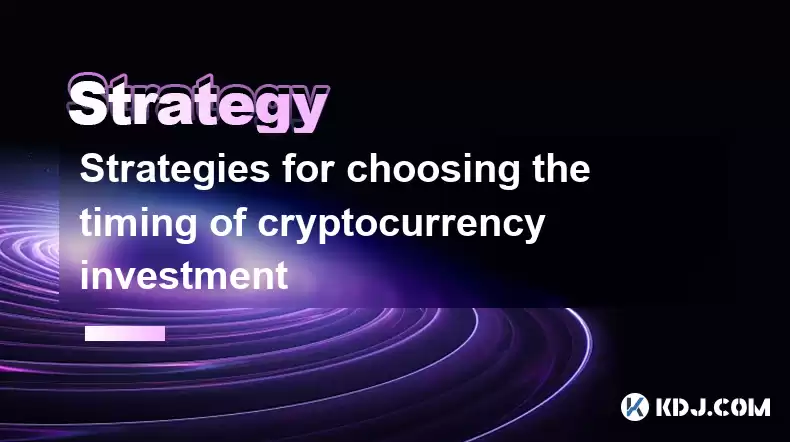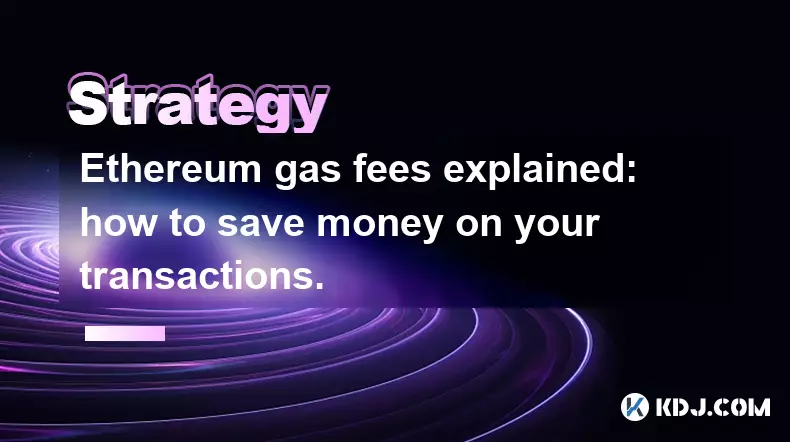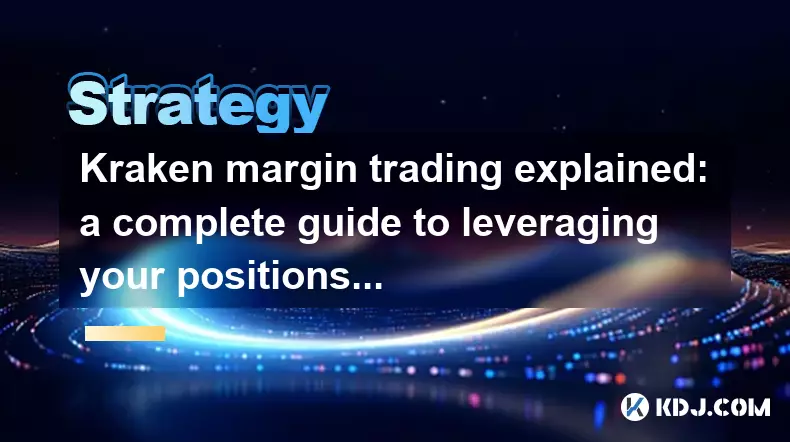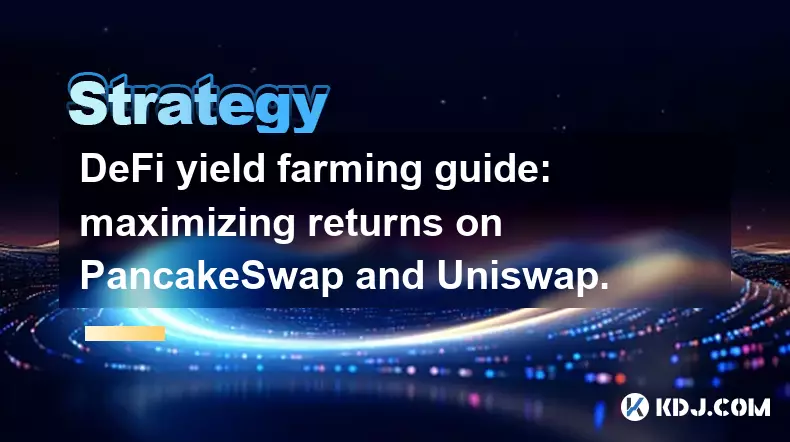-
 bitcoin
bitcoin $101752.865364 USD
-1.09% -
 ethereum
ethereum $3382.985899 USD
-1.38% -
 tether
tether $0.999658 USD
0.04% -
 xrp
xrp $2.272505 USD
-1.51% -
 bnb
bnb $989.089004 USD
0.14% -
 solana
solana $156.962612 USD
-3.08% -
 usd-coin
usd-coin $0.999776 USD
0.01% -
 tron
tron $0.290786 USD
-0.69% -
 dogecoin
dogecoin $0.174594 USD
-2.86% -
 cardano
cardano $0.560085 USD
-3.55% -
 hyperliquid
hyperliquid $40.023704 USD
-5.75% -
 chainlink
chainlink $15.324649 USD
-2.78% -
 bitcoin-cash
bitcoin-cash $493.576540 USD
-3.52% -
 zcash
zcash $571.320038 USD
-12.05% -
 stellar
stellar $0.280066 USD
-4.26%
Strategies for choosing the timing of cryptocurrency investment
Timing crypto investments is tricky due to volatility; use technical and fundamental analysis, DCA, stay informed, and manage risks to improve your chances of success.
Mar 28, 2025 at 04:43 pm

Understanding Market Volatility and Timing
Cryptocurrency markets are notoriously volatile. Price swings can be dramatic and unpredictable, making timing your investments crucial. There's no foolproof method, but understanding market forces and employing various strategies can improve your chances of buying low and selling high. Successfully navigating this volatility requires a blend of technical analysis, fundamental analysis, and a healthy dose of risk management. Ignoring market trends can lead to significant losses.
Technical Analysis: Charting the Course
Technical analysis uses historical price and volume data to predict future price movements. This involves studying charts to identify patterns, trends, and support/resistance levels. Indicators like moving averages, Relative Strength Index (RSI), and MACD can help gauge momentum and potential reversals. However, technical analysis is not a perfect predictor, and false signals are common. It's best used in conjunction with other methods.
- Identify support and resistance levels on price charts. These levels often indicate where price might bounce or break through.
- Use moving averages to identify trends and potential buy/sell signals. A common strategy is to look for crossovers of short-term and long-term moving averages.
- Employ RSI and MACD to gauge momentum and identify overbought or oversold conditions. These indicators can signal potential price reversals.
Fundamental Analysis: Beyond the Charts
Fundamental analysis focuses on the underlying value of a cryptocurrency. This involves assessing factors like the project's technology, team, adoption rate, and market capitalization. Strong fundamentals can suggest long-term growth potential, even amidst short-term price fluctuations. However, fundamental analysis alone doesn't guarantee short-term price gains.
- Research the technology behind the cryptocurrency. Is it innovative and scalable?
- Assess the team behind the project. Do they have a strong track record?
- Examine the adoption rate. Is the cryptocurrency being widely used and accepted?
- Analyze the market capitalization to gauge its relative size and potential for growth.
Dollar-Cost Averaging (DCA): A Steady Approach
Dollar-cost averaging involves investing a fixed amount of money at regular intervals, regardless of price. This strategy mitigates the risk of investing a large sum at a market peak. While it doesn't guarantee maximum profits, it reduces the impact of volatility and provides a consistent approach to building a portfolio. It's particularly suitable for long-term investors.
- Determine a fixed investment amount and schedule (e.g., weekly or monthly).
- Invest the predetermined amount regardless of price fluctuations.
- This strategy helps to average out the cost of your investments over time.
News and Events: Staying Informed
Major news events, regulatory announcements, and technological developments can significantly impact cryptocurrency prices. Staying informed about these factors can help you anticipate potential price movements and adjust your investment strategy accordingly. However, it's crucial to distinguish between credible and unreliable sources of information.
- Follow reputable cryptocurrency news outlets and social media accounts.
- Be aware of potential market manipulation and scams.
- Carefully consider the implications of regulatory changes and technological advancements.
Risk Management: Protecting Your Investments
Cryptocurrency investments are inherently risky. It's crucial to implement risk management strategies to protect your capital. This includes diversifying your portfolio, setting stop-loss orders, and only investing what you can afford to lose. Avoid emotional decision-making, which can lead to poor investment choices.
- Diversify your portfolio across different cryptocurrencies to reduce risk.
- Set stop-loss orders to limit potential losses.
- Only invest money you can afford to lose.
- Avoid emotional trading based on fear or greed.
Long-Term vs. Short-Term Strategies
Your investment timeline significantly impacts your timing strategy. Long-term investors often focus on fundamental analysis and DCA, while short-term traders rely more heavily on technical analysis and news events. Choosing a strategy that aligns with your investment goals and risk tolerance is essential.
- Long-term investors prioritize fundamental analysis and DCA.
- Short-term traders employ technical analysis and react to news events.
Considering Market Cycles
Cryptocurrency markets tend to follow cyclical patterns, with periods of bull markets (rising prices) and bear markets (falling prices). Understanding these cycles can help inform your timing decisions. However, predicting the exact timing of these cycles is difficult.
The Role of Sentiment Analysis
Sentiment analysis involves gauging the overall market sentiment towards a particular cryptocurrency or the market as a whole. Positive sentiment can indicate potential upward price movement, while negative sentiment might suggest a decline. However, sentiment can be subjective and influenced by hype or fear.
Using Social Media Sentiment
Social media platforms can provide insights into market sentiment. Analyzing the volume and tone of discussions about a cryptocurrency can offer clues about potential price movements. However, be aware of the potential for manipulation and misinformation on social media.
Combining Strategies for Optimal Results
The most effective approach often involves combining different strategies. For instance, you might use technical analysis to identify potential entry and exit points while relying on fundamental analysis to select promising cryptocurrencies. This integrated approach can help you make more informed investment decisions.
Frequently Asked Questions
Q: Is there a perfect timing strategy for cryptocurrency investments?A: No, there's no foolproof method to perfectly time the market. Cryptocurrency markets are highly volatile and unpredictable.
Q: How can I reduce the risk of investing in cryptocurrencies?A: Diversify your portfolio, use stop-loss orders, and only invest what you can afford to lose. Thorough research and risk management are crucial.
Q: What is the difference between technical and fundamental analysis?A: Technical analysis uses price charts and indicators to predict future price movements, while fundamental analysis assesses the underlying value of a cryptocurrency based on its technology, team, and adoption rate.
Q: How does dollar-cost averaging work?A: Dollar-cost averaging involves investing a fixed amount of money at regular intervals, regardless of price fluctuations, to average out your investment cost over time.
Q: How important is staying informed about news and events?A: Staying informed about news and events is crucial, as major announcements can significantly impact cryptocurrency prices. However, it's vital to distinguish credible sources from unreliable ones.
Disclaimer:info@kdj.com
The information provided is not trading advice. kdj.com does not assume any responsibility for any investments made based on the information provided in this article. Cryptocurrencies are highly volatile and it is highly recommended that you invest with caution after thorough research!
If you believe that the content used on this website infringes your copyright, please contact us immediately (info@kdj.com) and we will delete it promptly.
- Ripple (XRP) in 2026: Hold or Fold? A Look at XRP's Future and Emerging DeFi Alternatives
- 2025-11-08 18:35:01
- Zcash ZEC Coin Price Explosion: From Privacy Niche to Center Stage
- 2025-11-08 18:55:01
- Berachain Price Prediction: Navigating the Honeycomb Hype in Crypto
- 2025-11-08 18:55:01
- Arthur Hayes, Gold, and Bitcoin: A Modern Monetary Trinity?
- 2025-11-08 19:15:01
- Shiba Inu's Next Move: Navigating a Shifting Market
- 2025-11-08 19:20:01
- Pakistan's Crypto Crossroads: Balancing Opportunity with Asset-Backed Realities
- 2025-11-08 19:20:01
Related knowledge

Navigating a crypto bear market: strategies for survival and profit.
Nov 05,2025 at 02:04pm
Navigating a Crypto Bear Market: Strategies for Survival and Profit Surviving a crypto bear market requires more than just patience—it demands strateg...

Ethereum gas fees explained: how to save money on your transactions.
Nov 04,2025 at 04:01pm
Ethereum Gas Fees: Understanding the Basics1. Ethereum operates on a decentralized network where every transaction requires computational power to exe...

Kraken margin trading explained: a complete guide to leveraging your positions.
Nov 04,2025 at 02:19pm
Kraken Margin Trading Overview1. Kraken is one of the most established cryptocurrency exchanges offering margin trading to experienced traders seeking...

NFT flipping for beginners: a step-by-step guide to profitable trading.
Nov 02,2025 at 11:54pm
NFT Flipping Basics: Understanding the Market1. NFT flipping involves purchasing non-fungible tokens at a lower price and reselling them for profit, o...

DeFi yield farming guide: maximizing returns on PancakeSwap and Uniswap.
Nov 05,2025 at 12:20am
Understanding Yield Farming on PancakeSwap and Uniswap1. Yield farming has become a central activity in the decentralized finance (DeFi) space, allowi...

How to find the next 100x altcoin: a fundamental analysis checklist.
Nov 02,2025 at 09:54pm
Decentralized Exchanges Are Reshaping Trading Dynamics1. Decentralized exchanges (DEXs) have emerged as a powerful alternative to centralized platform...

Navigating a crypto bear market: strategies for survival and profit.
Nov 05,2025 at 02:04pm
Navigating a Crypto Bear Market: Strategies for Survival and Profit Surviving a crypto bear market requires more than just patience—it demands strateg...

Ethereum gas fees explained: how to save money on your transactions.
Nov 04,2025 at 04:01pm
Ethereum Gas Fees: Understanding the Basics1. Ethereum operates on a decentralized network where every transaction requires computational power to exe...

Kraken margin trading explained: a complete guide to leveraging your positions.
Nov 04,2025 at 02:19pm
Kraken Margin Trading Overview1. Kraken is one of the most established cryptocurrency exchanges offering margin trading to experienced traders seeking...

NFT flipping for beginners: a step-by-step guide to profitable trading.
Nov 02,2025 at 11:54pm
NFT Flipping Basics: Understanding the Market1. NFT flipping involves purchasing non-fungible tokens at a lower price and reselling them for profit, o...

DeFi yield farming guide: maximizing returns on PancakeSwap and Uniswap.
Nov 05,2025 at 12:20am
Understanding Yield Farming on PancakeSwap and Uniswap1. Yield farming has become a central activity in the decentralized finance (DeFi) space, allowi...

How to find the next 100x altcoin: a fundamental analysis checklist.
Nov 02,2025 at 09:54pm
Decentralized Exchanges Are Reshaping Trading Dynamics1. Decentralized exchanges (DEXs) have emerged as a powerful alternative to centralized platform...
See all articles





















![The Graph Price Prediction [GRT Crypto Price News Today] The Graph Price Prediction [GRT Crypto Price News Today]](/uploads/2025/11/07/cryptocurrencies-news/videos/690d4df44fe69_image_500_375.webp)




















































